Introduction
In the realm of data analysis, the ability to generate dynamic sequences of numbers can be a game-changer for organizations striving for operational excellence. The GENERATESERIES function in DAX emerges as a powerful ally, enabling users to create single-column tables filled with sequential numeric values, tailored to their specific needs. This function not only simplifies complex calculations but also enhances data modeling within Power BI, setting the stage for insightful analytics that drive strategic decisions.
As organizations navigate the intricacies of data management, mastering GENERATESERIES can unlock new levels of efficiency, empowering teams to transform raw data into actionable insights and fostering a culture of informed decision-making that propels business growth.
Understanding the GENERATESERIES Function in DAX
The dax generateseries feature in DAX is a powerful tool designed to create a single-column table filled with sequential numeric values. Its syntax is straightforward: <Start>, <And>, <Increment>. Here, <Start> indicates the initial value, <And> represents the final value, and <Increment> specifies the step size between values.
This procedure plays a vital role in producing dynamic sequences of numbers, which are necessary for various computations, visualizations, and modeling tasks within Power BI. Significantly, users should recognize that a maximum of 99,999 rows can be returned per query, highlighting the necessity for effective information modeling practices that improve operational efficiency.
By mastering dax generateseries, users can unlock the full potential of DAX, leading to the creation of robust models that enable insightful analytics. For example, in practical applications, it enables users to create timelines, dax generateseries for forecasting, or establish ranges for visualizations—key elements in driving data-driven insights that propel business growth. The capability to handle these calculations effectively is additionally illustrated by recent improvements in DAX operations, which boost overall performance and enable users to address issues related to time-consuming report creation and information inconsistencies.
This is especially pertinent in the context of the ‘Query Tabs’ feature, which supports multiple queries, enabling users to manage and utilize the series generation tool more effectively, thereby enhancing productivity and operational insight. Furthermore, integrating RPA solutions like EMMA RPA and Power Automate can automate repetitive tasks related to manipulation, thereby improving efficiency. As mentioned by Data Science enthusiast Douglas Rocha, ‘Last but certainly not least is the Mode,’ which highlights the significance of choosing the appropriate operations for effective utilization of information, especially when dax generateseries is utilized.
Ultimately, comprehending and utilizing dax generateseries capability can greatly enhance modeling efficiency, allowing Directors of Operations Efficiency to leverage actionable insights for informed decision-making and innovation.
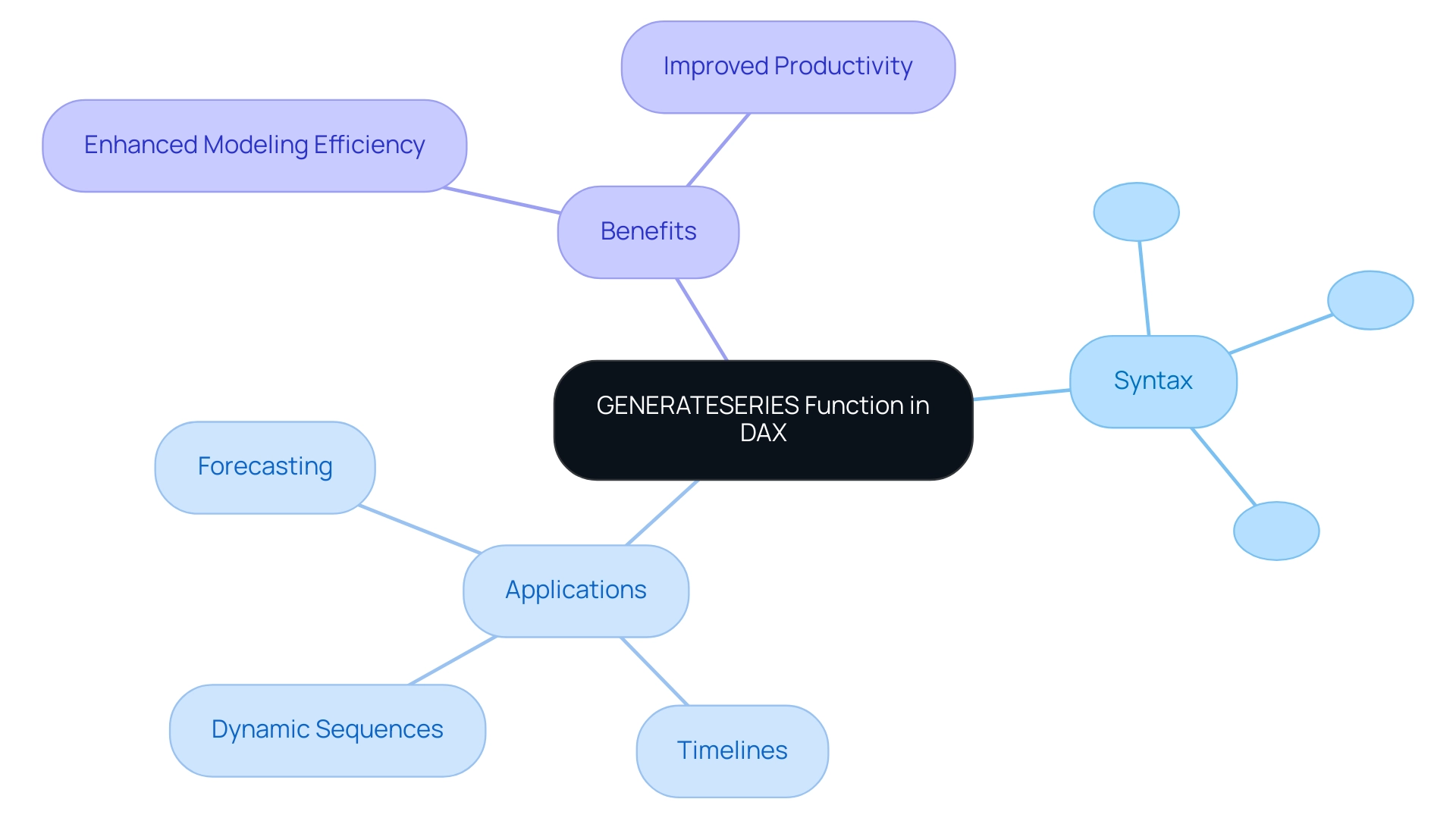
Practical Applications and Examples of GENERATESERIES in Power BI
The GENERATESERIES function in Power BI offers versatile applications that can significantly enhance your data analysis capabilities, especially in the context of driving operational efficiency and extracting actionable insights:
-
Dynamic Date Ranges: The dax generateseries function is essential for facilitating the generation of a continuous series of dates, which is crucial for time intelligence calculations. For instance, using
DATE(1, 1, 1)toDATE(1, 1, 1)with an interval of 1 enables the creation of a comprehensive calendar table for the year, providing a robust framework for time-based analysis that can inform strategic decisions. -
Custom Bins: Another powerful application of the dax generateseries function is in the creation of custom bins for numerical datasets. For example, to classify sales data into defined ranges, the method can be utilized as follows:
0, 1000, 100. This effectively segments sales into bins such as 0-100, 101-200, and so on, allowing for clearer insights into sales performance and trends, thus addressing common challenges in reporting. -
Parameter Tables: Additionally, you can utilize the dax generateseries function for crafting parameter tables that support what-if analysis. By dynamically adjusting values such as discount percentages or interest rates, you enhance the interactivity and responsiveness of your reports, enabling more informed decision-making. This approach not only enriches your analytics but also empowers your team to explore various scenarios effectively, contributing to a culture of data-driven insights.
Furthermore, the popularity of this feature is underscored by the fact that the related message received 4,485 views, indicating significant interest in its applications. However, users should be cautious of the ‘sampling monster,’ as noted by Power BI expert lbendlin: “You have fallen victim to the sampling monster. Nothing you can do about it – except for using (much) smaller ranges or larger interval steps.”
This caution is especially pertinent considering a case study where a user faced a problem with the function, leading to unexpected outputs when larger values were inputted. The problem was attributed to the ‘sampling monster,’ highlighting the importance of using smaller ranges or larger interval steps to achieve accurate results.
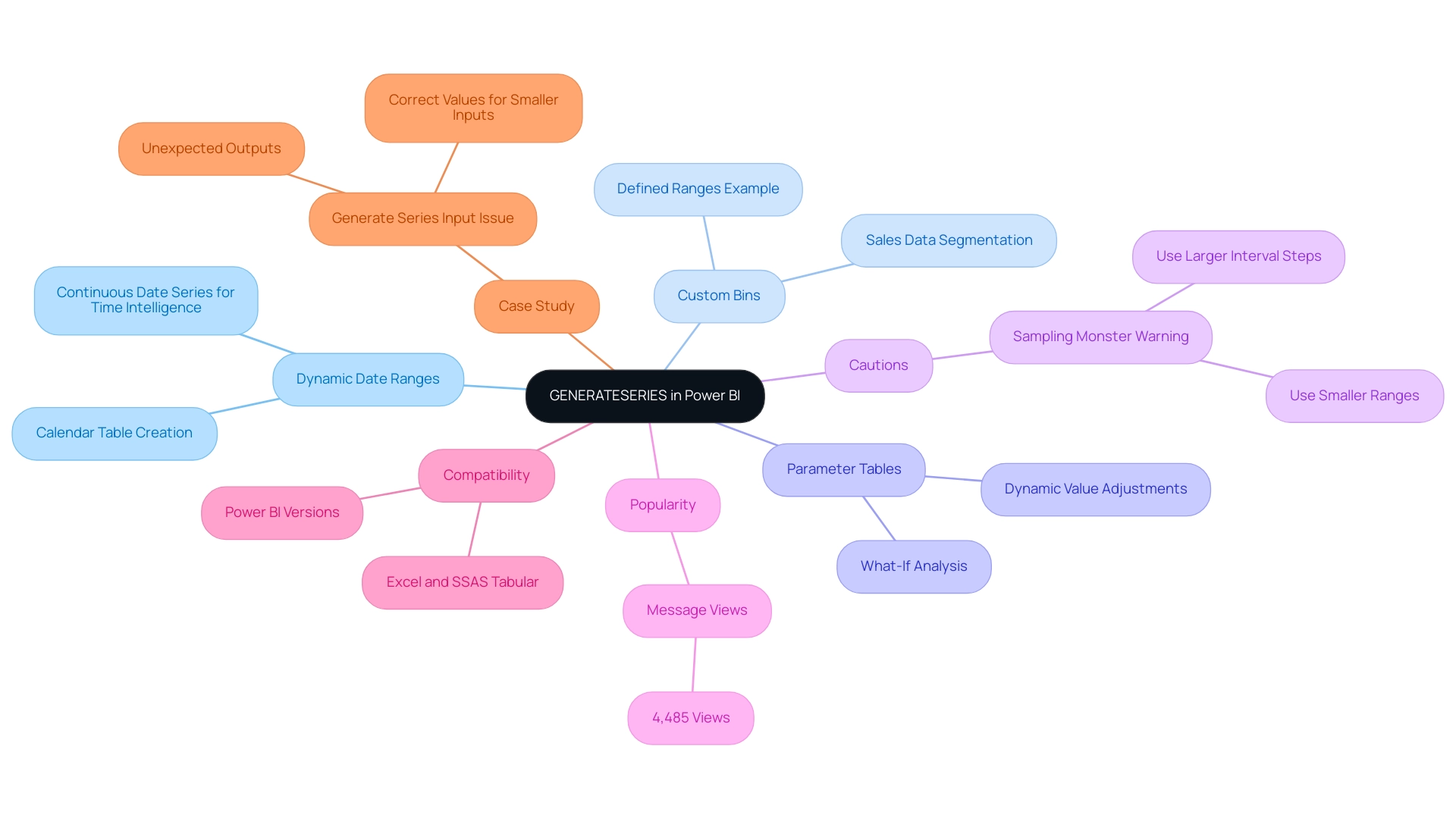
Advanced Techniques: Leveraging GENERATESERIES for Complex Data Models
To effectively utilize the potential of the series generator in advanced information scenarios while leveraging Robotic Process Automation (RPA) for improved operational efficiency, consider the following strategies:
-
By utilizing
dax generateseriesin conjunction withCALCULATE, you can craft dynamic measures tailored to user-selected parameters. This combination allows for more nuanced insights, adapting to the variables and filters applied by users, ultimately enhancing the decision-making process. RPA can automate information collection and processing, ensuring that the details feeding into these measures are timely and accurate. As experts suggest, it is vital to test extensively to validate formulas in different contexts for accuracy, ensuring that your insights are reliable. Moreover, automating these processes usingdax generateseriesreduces the likelihood of human error, freeing up your team to focus on more strategic tasks. -
Combining with FILTER: Utilize
dax generateseriesto establish complex filtering conditions based on external criteria. For example, the expressionFILTER(Sales, Sales[Amount] > SERIES(0, 1000, 100))offers a robust method to extract insights from sales information that surpass specific thresholds, allowing focused analysis of performance metrics. By automating this process through RPA, you can ensure consistent information analysis without manual intervention, which drives operational efficiency and mitigates the risks associated with repetitive manual tasks, especially whendax generateseriesis utilized for data management. -
Dynamic Chart Axis: Utilizing a
dax generateseriesfunction allows for the creation of dynamic axes within visual representations. This functionality not only improves presentation but also provides users the flexibility to interactively adjust ranges, resulting in a more engaging user experience. A pertinent case study is the Time Series Analysis, where DAX functions likeTOTALYTDandSAMEPERIODLASTYEARcan be utilized alongsidedax generateseriesto analyze trends over time, identifying patterns and seasonality within sequential information points.
As Yash Sinha emphasizes,
Master analytics and tech with top-notch resources in Power BI, SQL, Machine Learning, and AI. Enhance your abilities and remain ahead in the information game!
These techniques exemplify how advanced DAX capabilities, combined with RPA, can transform your insights, enabling more informed decision-making and driving business growth while addressing the challenges posed by manual workflows.
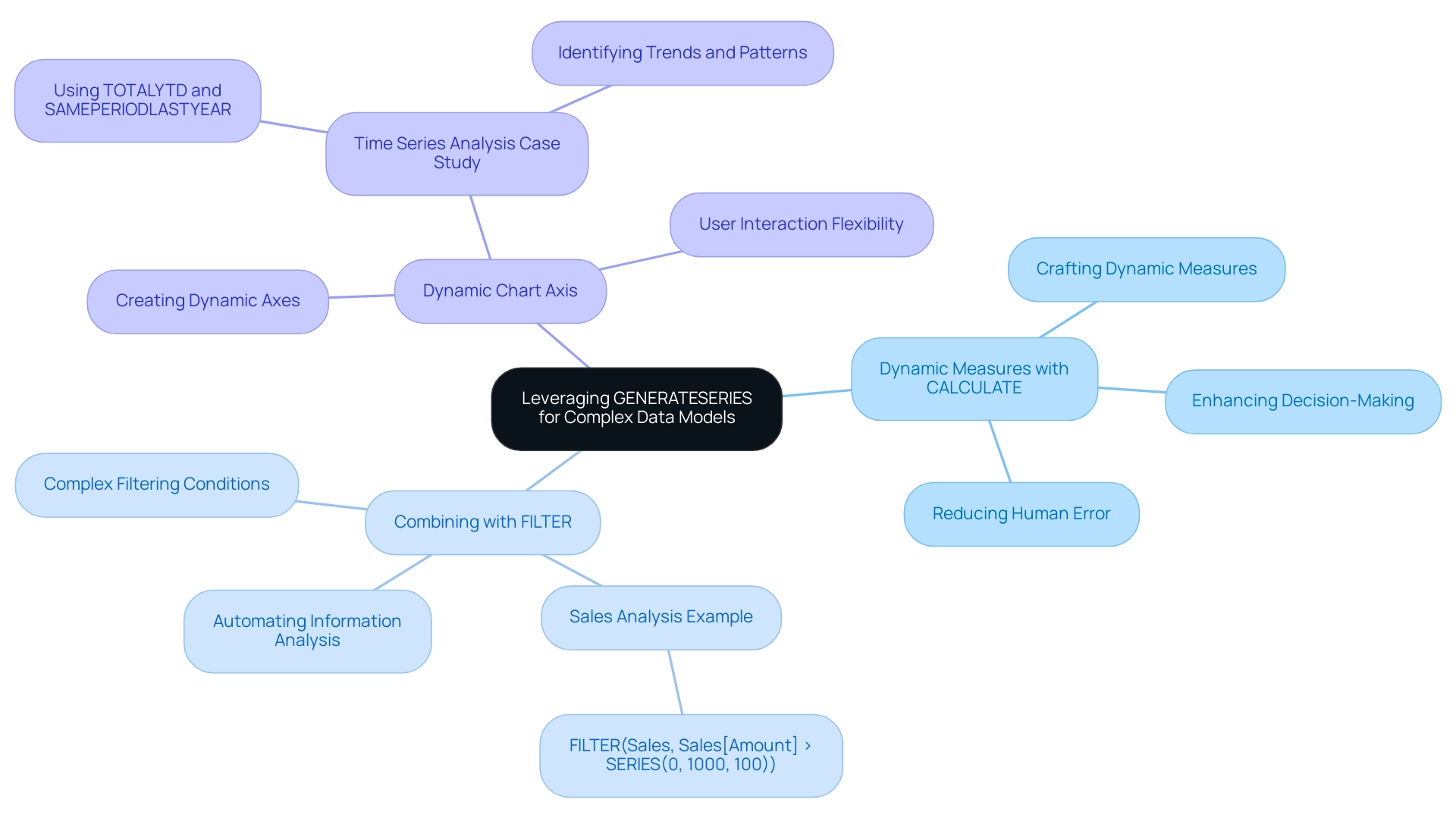
Troubleshooting Common Issues with GENERATESERIES
When employing the dax generateseries feature in DAX, several common issues may arise that can hinder performance and accuracy. Here are the key challenges and their solutions:
-
Incorrect Syntax: It’s crucial to verify that the start, end, and increment values are accurately defined and compatible in terms of type. Misconfigurations in syntax can lead to errors or yield unexpected outcomes. Ensuring precision in these definitions is essential for generating reliable results.
-
Performance Issues: Generating large series can adversely impact performance. To enhance efficiency and overcome technology implementation challenges, it is advisable to limit the numerical range being generated or to utilize calculated columns as an alternative approach. This strategy not only optimizes performance but also simplifies the overall calculation process within Power BI. In fact, creating calculated columns or flags in the backend can significantly improve performance, as demonstrated in the case study titled “Work Upstream for Complex Calculations.” Moreover, Robotic Process Automation (RPA) can be employed to automate repetitive tasks associated with DAX implementations, reducing the likelihood of manual errors and further streamlining the process.
-
Data Type Mismatches: Alignment of types across DAX operations is essential. For instance, using an integer in place of a decimal can result in calculation errors. Ensuring that data types are consistent is a fundamental practice that can prevent complications during analysis.
Additionally, for virtual relationships, it is suggested to use TREATAS instead of INTERSECT or FILTER to maintain filter context effectively, which is essential for optimizing DAX operations.
Mazhar Shakeel aptly notes, > Remember, Power BI is a tool that rewards careful planning and thoughtful design. < By addressing these common issues with foresight and strategic adjustments, you can significantly enhance the effectiveness of your DAX implementations and use dax generateseries to optimize performance in your reports. Embracing tailored AI solutions and leveraging Business Intelligence tools can further empower informed decision-making, ensuring your operations are both efficient and competitive.
Business Intelligence can convert insights obtained from DAX calculations into actionable strategies that promote growth. It is also important to note that the LINEST and LINESTX calculations require at least the Jan/Feb 2023 version of Power BI Desktop, which underscores the importance of using the latest tools for optimal performance.
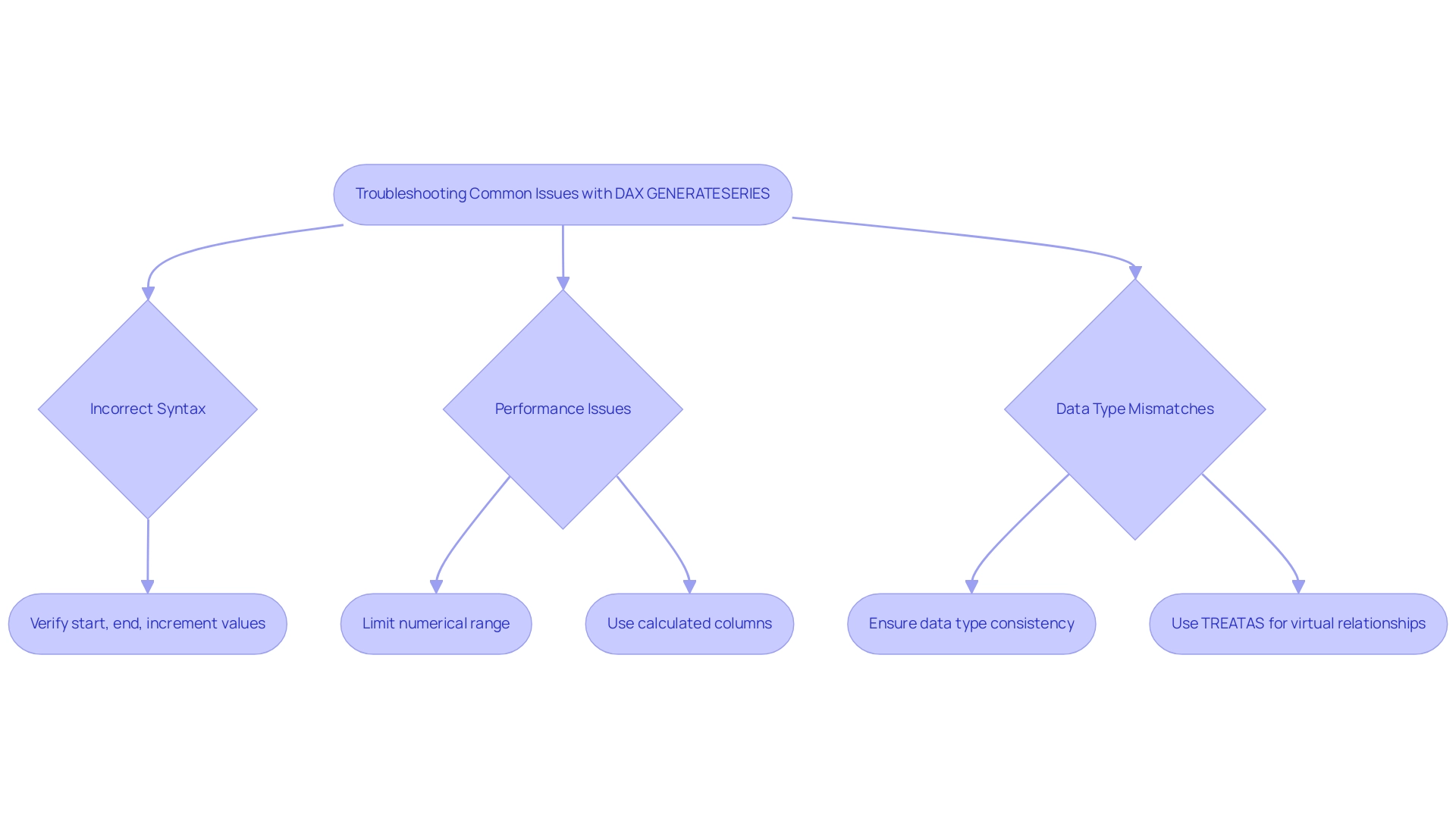
Future Trends: The Evolution of DAX and GENERATESERIES
The evolution of DAX, particularly the GENERATESERIES feature, is poised to be influenced by several significant trends:
-
Increased Integration with AI: As artificial intelligence continues to advance, we can anticipate a deeper integration within DAX functions. This evolution will facilitate smarter information manipulation and enhance predictive analytics capabilities, aligning with the expectations of 70% of individuals who foresee AI accelerating content generation processes. However, it’s crucial to acknowledge that only 39% of U.S. adults believe that current AI technologies are safe and secure, highlighting a common reluctance rooted in perceptions of complexity and cost. Addressing these concerns, including the impact of poor master information quality on AI effectiveness, will be essential for successful AI adoption.
-
Enhanced User Interfaces: The future of DAX also points toward improved user interfaces, making DAX formulas more accessible for non-technical users. This development is crucial, especially as 88% of consumers now expect brands to provide self-service portals for quicker solutions. Simplifying DAX tools, such as how dax generateseries, will empower more users to harness their capabilities effectively, reducing the resistance linked to technology implementation.
-
Greater Performance Enhancement: With the ever-increasing volume of information, future updates to DAX will likely focus on performance optimization. Improvements focused on providing quicker calculations and more effective information management will be crucial for sustaining operational efficiency and addressing the increasing demands of users. Leveraging innovative tools, such as Robotic Process Automation (RPA), can significantly enhance workflow efficiency, freeing up resources for more strategic initiatives and addressing issues related to data quality that can hinder AI implementation.
-
Ethical Considerations in AI Integration: As DAX evolves with AI, it is imperative to consider ethical practices, user trust, and regulatory frameworks in AI development. Addressing these challenges will be essential for fostering a positive perception of AI technologies and ensuring that they are implemented responsibly, thus overcoming the barriers to their acceptance.
By staying ahead of these trends, operations leaders can not only improve their analytics capabilities but also build a data-driven culture that leverages Business Intelligence for informed decision-making. This approach will help mitigate the common perceptions that AI projects are time-intensive and costly, positioning their organizations to thrive in an increasingly competitive landscape.
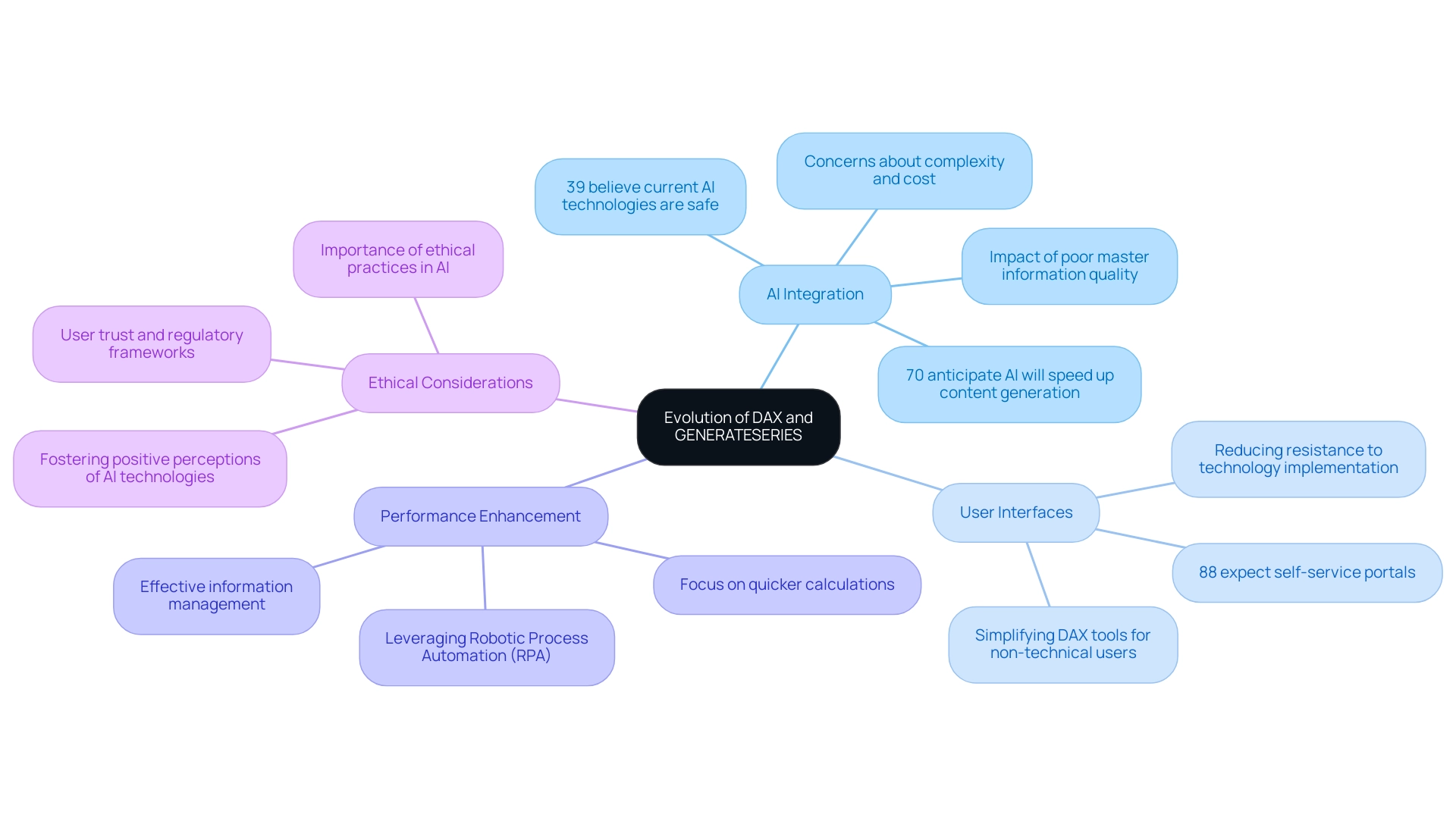
Conclusion
The effective use of the GENERATESERIES function in DAX is essential for organizations aiming to enhance their data analysis capabilities. By mastering this function, teams can create dynamic series of numbers that facilitate a range of applications, from generating custom bins for data segmentation to developing comprehensive date ranges for time-based analysis. Such versatility not only streamlines complex calculations but also supports the creation of robust data models in Power BI, ultimately driving actionable insights that support strategic decisions.
Moreover, integrating GENERATESERIES with advanced techniques like CALCULATE and FILTER allows for more nuanced data analysis, enabling teams to extract meaningful insights tailored to specific criteria. As organizations increasingly adopt robotic process automation (RPA) solutions, they can automate repetitive tasks linked to data manipulation, further enhancing operational efficiency and accuracy. Addressing common challenges such as incorrect syntax and performance issues through careful planning and strategic adjustments ensures that the potential of DAX is fully realized.
Looking ahead, the evolution of DAX, particularly with trends like AI integration and user-friendly interfaces, presents exciting opportunities for operational leaders. By embracing these advancements, organizations can foster a culture of data-driven decision-making, empowering teams to leverage insights for innovation and growth. As the landscape of data analysis continues to evolve, staying informed and adaptable will be key to maintaining a competitive edge.

